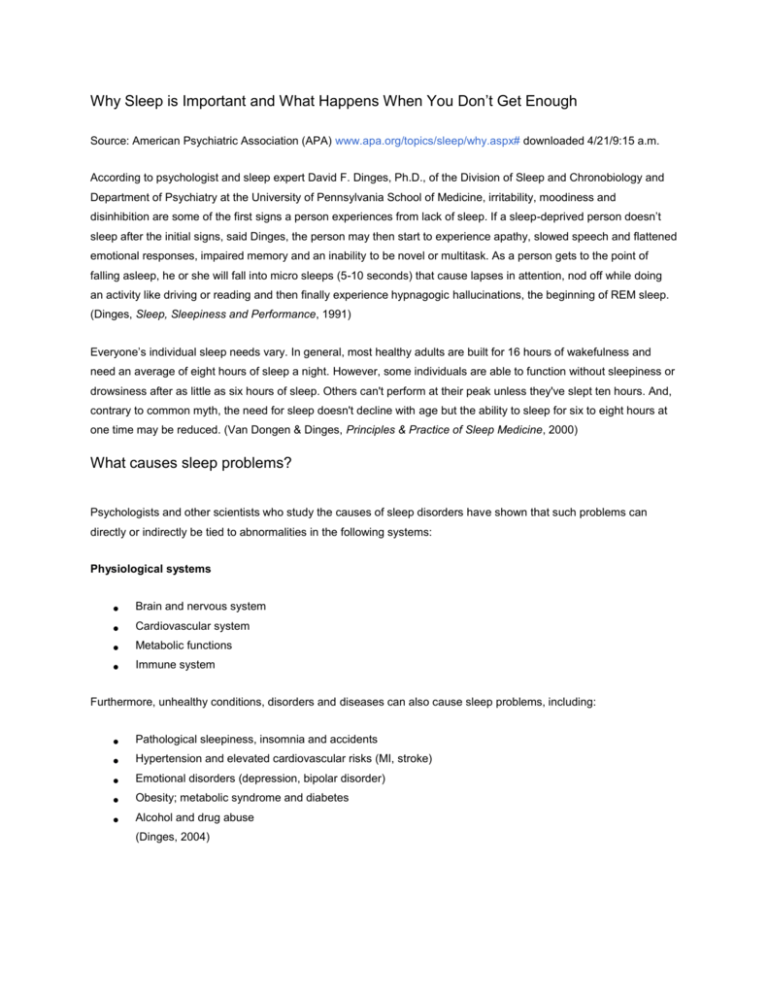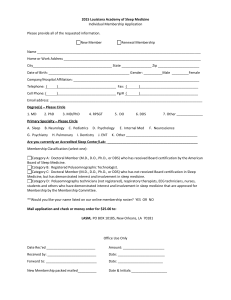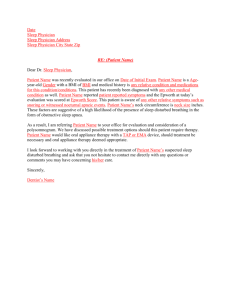
Why Sleep is Important and What Happens When You Don’t Get Enough
Source: American Psychiatric Association (APA) www.apa.org/topics/sleep/why.aspx# downloaded 4/21/9:15 a.m.
According to psychologist and sleep expert David F. Dinges, Ph.D., of the Division of Sleep and Chronobiology and
Department of Psychiatry at the University of Pennsylvania School of Medicine, irritability, moodiness and
disinhibition are some of the first signs a person experiences from lack of sleep. If a sleep-deprived person doesn’t
sleep after the initial signs, said Dinges, the person may then start to experience apathy, slowed speech and flattened
emotional responses, impaired memory and an inability to be novel or multitask. As a person gets to the point of
falling asleep, he or she will fall into micro sleeps (5-10 seconds) that cause lapses in attention, nod off while doing
an activity like driving or reading and then finally experience hypnagogic hallucinations, the beginning of REM sleep.
(Dinges, Sleep, Sleepiness and Performance, 1991)
Everyone’s individual sleep needs vary. In general, most healthy adults are built for 16 hours of wakefulness and
need an average of eight hours of sleep a night. However, some individuals are able to function without sleepiness or
drowsiness after as little as six hours of sleep. Others can't perform at their peak unless they've slept ten hours. And,
contrary to common myth, the need for sleep doesn't decline with age but the ability to sleep for six to eight hours at
one time may be reduced. (Van Dongen & Dinges, Principles & Practice of Sleep Medicine, 2000)
What causes sleep problems?
Psychologists and other scientists who study the causes of sleep disorders have shown that such problems can
directly or indirectly be tied to abnormalities in the following systems:
Physiological systems
Brain and nervous system
Cardiovascular system
Metabolic functions
Immune system
Furthermore, unhealthy conditions, disorders and diseases can also cause sleep problems, including:
Pathological sleepiness, insomnia and accidents
Hypertension and elevated cardiovascular risks (MI, stroke)
Emotional disorders (depression, bipolar disorder)
Obesity; metabolic syndrome and diabetes
Alcohol and drug abuse
(Dinges, 2004)
Groups that are at particular risk for sleep deprivation include night shift workers, physicians (average sleep = 6.5
hours a day; residents = 5 hours a day), truck drivers, parents and teenagers. (American Academy of Sleep Medicine
and National Heart, Lung, and Blood Institute Working Group on Problem Sleepiness. 1997).
Health problems and sleep disorders
A number of physical problems can interfere with your ability to fall or stay asleep. For example, arthritis and other
conditions that cause pain, backache, or discomfort can make it difficult to sleep well.
Epidemiological studies suggest self-reported sleep complaints are associated with an increased relative risk of
cardiovascular morbidity and mortality. For women, pregnancy and hormonal shifts including those that cause
premenstrual syndrome (PMS) or menopause and its accompanying hot flashes can also intrude on sleep.
Finally, certain medications such as decongestants, steroids and some medicines for high blood pressure, asthma, or
depression can cause sleeping difficulties as a side effect.
It is a good idea to talk to a physician or mental health provider about any sleeping problem that recurs or persists for
longer than a few weeks.
According to the DSM IV, some psychiatric disorders have fatigue as a major symptom. Included are: major
depressive disorder (includes postpartum blues), minor depression, dythymia, mixed anxiety-depression, SAD and
bipolar disorder.
According to a long-term study published in the 2004 April issue of Alcoholism: Clinical and Experimental Research,
young teenagers whose preschool sleep habits were poor were more than twice as likely to use drugs, tobacco or
alcohol. This finding was made by the University of Michigan Health System as part of a family health study that
followed 257 boys and their parents for 10 years. The study found a significant connection between sleep problems in
children and later drug use, even when other issues such as depression, aggression, attention problems and parental
alcoholism were taken into account. Long-term data on girls isn't available yet. The researchers suggest that early
sleep problems may be a "marker" for predicting later risk of early adolescent substance abuse—and that there may
be a common biological factor underlying both traits. Although the relationship between sleep problems and the
abuse of alcohol in adults is well known, this is the first study to look at the issue in children.
Children and Sleep Disturbances
Nightmares are dreams with vivid and disturbing content. They are common in children during REM sleep. They
usually involve an immediate awakening and good recall of the dream content.
Sleep terrors are often described as extreme nightmares. Like nightmares, they most often occur during childhood,
however they typically take place during non-REM (NREM) sleep. Characteristics of a sleep terror include arousal,
agitation, large pupils, sweating, and increased blood pressure. The child appears terrified, screams and is usually
inconsolable for several minutes, after which he or she relaxes and returns to sleep. Sleep terrors usually take place
early in the night and may be combined with sleepwalking. The child typically does not remember or has only a vague
memory of the terrifying events.
Sleepiness and Decision Making
In the August 2004 issue of the journal Sleep, Dr. Timothy Roehrs, the Director of research at the Sleep Disorders
and Research Center at Henry Ford Hospital in Detroit published one of the first studies to measure the effect of
sleepiness on decision making and risk taking. He found that sleepiness does take a toll on effective decision making.
Cited in the October 12, New York Times Science section, Dr. Roehrs and his colleagues paid sleepy and fully alert
subjects to complete a series of computer tasks. At random times, they were given a choice to take their money and
stop. Or they could forge ahead with the potential of either earning more money or losing it all if their work was not
completed within an unknown remainder of time.
Dr. Roehrs found that the alert people were very sensitive to the amount of work they needed to do to finish the tasks
and understood the risk of losing their money if they didn't. But the sleepy subjects chose to quit the tasks
prematurely or they risked losing everything by trying to finish the task for more money even when it was 100 percent
likely that they would be unable to finish, said Dr. Roehrs.
Consequences of lost sleep
According to the National Commission on Sleep Disorders Research (1998) and reports from the National Highway
Safety Administration (NHSA)(2002), high-profile accidents can partly be attributed to people suffering from a severe
lack of sleep.
Each year the cost of sleep disorders, sleep deprivation and sleepiness, according to the NCSDR, is estimated to be
$15.9 million in direct costs and $50 to $100 billion a year in indirect and related costs. And according to the NHSA,
falling asleep while driving is responsible for at least 100,000 crashes, 71,000 injuries and 1,550 deaths each year in
the United States. Young people in their teens and twenties, who are particularly susceptible to the effects of chronic
sleep loss, are involved in more than half of the fall-asleep crashes on the nation's highways each year. Sleep loss
also interferes with the learning of young people in our nation's schools, with 60 percent of grade school and high
school children reporting that they are tired during the daytime and 15 percent of them admitting to falling asleep in
class.
According to the Department of Transportation (DOT), one to four percent of all highway crashes are due to
sleepiness, especially in rural areas and four percent of these crashes are fatal.
Risk factors for drowsy driving crashes:
1.
Late night/early morning driving
2.
Patients with untreated excessive sleepiness
3.
People who obtain six or fewer hours of sleep per day
4.
Young adult males
5.
Commercial truck drivers
6.
Night shift workers
7.
Medical residents after their shift
How to get a good night sleep
According to sleep researchers, a night's sleep is divided into five continually shifting stages, defined by types of brain
waves that reflect either lighter or deeper sleep. Toward morning, there is an increase in rapid eye movement, or
REM sleep, when the muscles are relaxed and dreaming occurs, and recent memories may be consolidated in the
brain. The experts say that hitting a snooze alarm over and over again to wake up is not the best way to feel rested.
“The restorative value of rest is diminished, especially when the increments are short,” said psychologist Edward
Stepanski, PhD who has studied sleep fragmentation at the Rush University Medical Center in Chicago. This on and
off again effect of dozing and waking causes shifts in the brain-wave patterns. Sleep-deprived snooze-button addicts
are likely to shorten their quota of REM sleep, impairing their mental functioning during the day. (New York Times,
October 12, 2004)
Certain therapies, like cognitive behavioral therapy teach people how to recognize and change patterns of thought
and behavior to solve their problems. Recently this type of therapy has been shown to be very effective in getting
people to fall asleep and conquer insomnia.
According to a study published in the October 2004 issue of The Archives of Internal Medicine, cognitive behavior
therapy is more effective and lasts longer than a widely used sleeping pill, Ambien, in reducing insomnia. The study
involved 63 healthy people with insomnia who were randomly assigned to receive Ambien, the cognitive behavior
therapy, both or a placebo. The patients in the therapy group received five 30-minute sessions over six weeks. They
were given daily exercises to “recognize, challenge and change stress-inducing” thoughts and were taught
techniques, like delaying bedtime or getting up to read if they were unable to fall asleep after 20 minutes. The
patients taking Ambien were on a full dose for a month and then were weaned off the drug. At three weeks, 44
percent of the patients receiving the therapy and those receiving the combination therapy and pills fell asleep faster
compared to 29 percent of the patients taking only the sleeping pills. Two weeks after all the treatment was over, the
patients receiving the therapy fell asleep in half the time it took before the study and only 17 percent of the patients
taking the sleeping pills fell asleep in half the time. (New York Times, October 5, 2004)
According to leading sleep researchers, there are techniques to combat common sleep problems:
Keep a regular sleep/wake schedule
Don’t drink or eat caffeine four to six hours before bed and minimize daytime use
Don’t smoke, especially near bedtime or if you awake in the night
Avoid alcohol and heavy meals before sleep
Get regular exercise
Minimize noise, light and excessive hot and cold temperatures where you sleep
Develop a regular bed time and go to bed at the same time each night
Try and wake up without an alarm clock
Attempt to go to bed earlier every night for certain period; this will ensure that you’re getting enough sleep
In clinical settings, cognitive-behavior therapy (CBT) has a 70-80 percent success rate for helping those who
Insomnia and cognitive-behavioral treatment
suffer from chronic insomnia. Almost one third of people with insomnia achieve normal sleep and most
reduce their symptoms by 50 percent and sleep an extra 45-60 minutes a night. When insomnia exists along
with other psychological disorders like depression, say the experts, the initial treatment should address the
underlying condition.
But sometimes even after resolving the underlying condition, the insomnia still exists, says psychologist Jack
Edinger, Ph.D., of the VA Medical Center in Durham, North Carolina and Professor of Psychiatry and
Behavioral Sciences at Duke University and cautions that treating the depression usually doesn’t resolve the
sleep difficulties. From his clinical experience, he has found that most patients with insomnia should be
examined for specific behaviors and thoughts that may perpetuate the sleep problems. When people
develop insomnia, they try to compensate by engaging in activities to help them get more sleep. They sleep
later in the mornings or spend excessive times in bed. These efforts usually backfire, said Edinger.
From his clinical work and research on sleep, psychologist Charles M. Morin, Ph.D., a Professor in the
Psychology Department and Director of the Sleep Disorders Center at University Laval in Quebec, Canada
says that ten percent of adults suffer from chronic insomnia. In a study released in the recent issue of Sleep
Medicine Alert published by the NSF, Morin outlines how CBT helps people overcome insomnia. Clinicians
use sleep diaries to get an accurate picture of someone’s sleep patterns. Bedtime, waking time, time to fall
asleep, number and durations of awakening, actual sleep time and quality of sleep are documented by the
person suffering from insomnia.
A person can develop poor sleep habits (i.e. watching TV in bed or eating too much before bedtime),
irregular sleep patterns (sleeping too late, taking long naps during the day) to compensate for lost sleep at
night. Some patients also develop a fear of not sleeping and a pattern of worrying about the consequences
of not sleeping, said Morin. “Treatments that address the poor sleep habits and the faulty beliefs and
attitudes about sleep work but sometimes,” said Morin, “medication may play a role in breaking the cycle of
insomnia. But behavioral therapies are essential for patients to alter the conditions that perpetuate it.”
CBT attempts to change a patient’s dysfunctional beliefs and attitudes about sleep. “It restructure thoughts –
like, ‘I’ve got to sleep eight hours tonight’ or ‘I’ve got to take medication to sleep’ or ‘I just can’t function or I’ll
get sick if I don’t sleep.’ These thoughts focus too much on sleep, which can become something like
performance anxiety – sleep will come around to you when you’re not chasing it,” said Edinger.
What works in many cases, said Morin and Edinger, is to standardize or restrict a person’s sleep to give a
person more control over his or her sleep. A person can keep a sleep diary for a couple of weeks and a
clinician can monitor the amount of time spent in bed to the actual amount of time sleeping. Then the
clinician can instruct the patient to either go to bed later and get up earlier or visa versa. This procedure
improves the length of sleeping time by imposing a mild sleep deprivation situation, which has the result of
reducing the anxiety surrounding sleep. To keep from falling asleep during the day, patients are told not to
restrict sleep to less than five hours.
Standardizing sleep actually helps a person adjust his or her homeostatic mechanism that balances sleep,
said Edinger. “Therefore, if you lose sleep, your homeostatic mechanism will kick in and will work to increase
the likelihood of sleeping longer and deeper to promote sleep recovery. This helps a person come back to
their baseline and works for the majority.”
A person can also establish more stimulus control over his or her bedroom environment, said Dr Morin. This
could include: going to bed only when sleepy, getting out of bed when unable to sleep, prohibiting non-sleep
activities in the bedroom, getting up at the same time every morning (including weekends) and avoiding
daytime naps.
Finally, a person can incorporate relaxation techniques as part of his or her treatment. For example, a
person can give herself or himself an extra hour before bed to relax and unwind and time to write down
worries and plans for the following day.
In CBT, said Morin, breaking the thought process and anxiety over sleep is the goal. “After identifying the
dysfunctional thought patterns, a clinician can offer alternative interpretations of what is getting the person
anxious so a person can think about his or her insomnia in a different way.” Morin offers some techniques to
restructure a person’s cognitions. “Keep realistic expectations, don’t blame insomnia for all daytime
impairments, do not feel that losing a night’s sleep will bring horrible consequences, do not give too much
importance to sleep and finally develop some tolerance to the effects of lost sleep.
According to Dr. Edinger, aging weakens a person’s homeostatic sleep drive after age 50. Interestingly, the
length of the circadian cycle stays roughly the same over the lifespan but the amplitude of the circadian
rhythm may decline somewhat with aging.
Resources
National Sleep Foundation
http://www.sleepfoundation.org/
American Academy of Sleep Medicine
http://www.aasmnet.org/
American Insomnia Association
http://www.americaninsomniaassociation.org/
Sleep Research Society
http://www.sleepresearchsociety.org/
NIH National Center for Sleep Disorders Research
http://www.nhlbi.nih.gov/sleep
The MayoClinic.com Sleep Center
(Blake, et al, Psychological Reports, 1998; National Heart, Lung and Blood Institute Working Group on
Insomnia, 1998)
David F. Dinges, PhD, Professor of Psychology in Psychiatry, Chief, Division of Sleep and Chronobiology,
University of Pennsylvania School of Medicine
Jack Edinger, PhD, of the VA Medical Center in Durham, North Carolina and Professor of Psychiatry and
Behavioral Sciences at Duke University
Charles M. Morin, PhD, a Professor in the Psychology Department and Director of the Sleep Disorders
Center at University Laval in Quebec, Canada
Timothy Roehrs, PhD, the Director of Research, Sleep Disorders and Research Center at Henry Ford
Hospital
Edward Stepanski, PhD, who has studied sleep fragmentation at the Rush University Medical Center in
Chicago
-------------------------------------------------------------------------------Office of Public Communications
American Psychological Association
Washington, DC
(202) 336-5700
February 2005
(All rights reserved)






